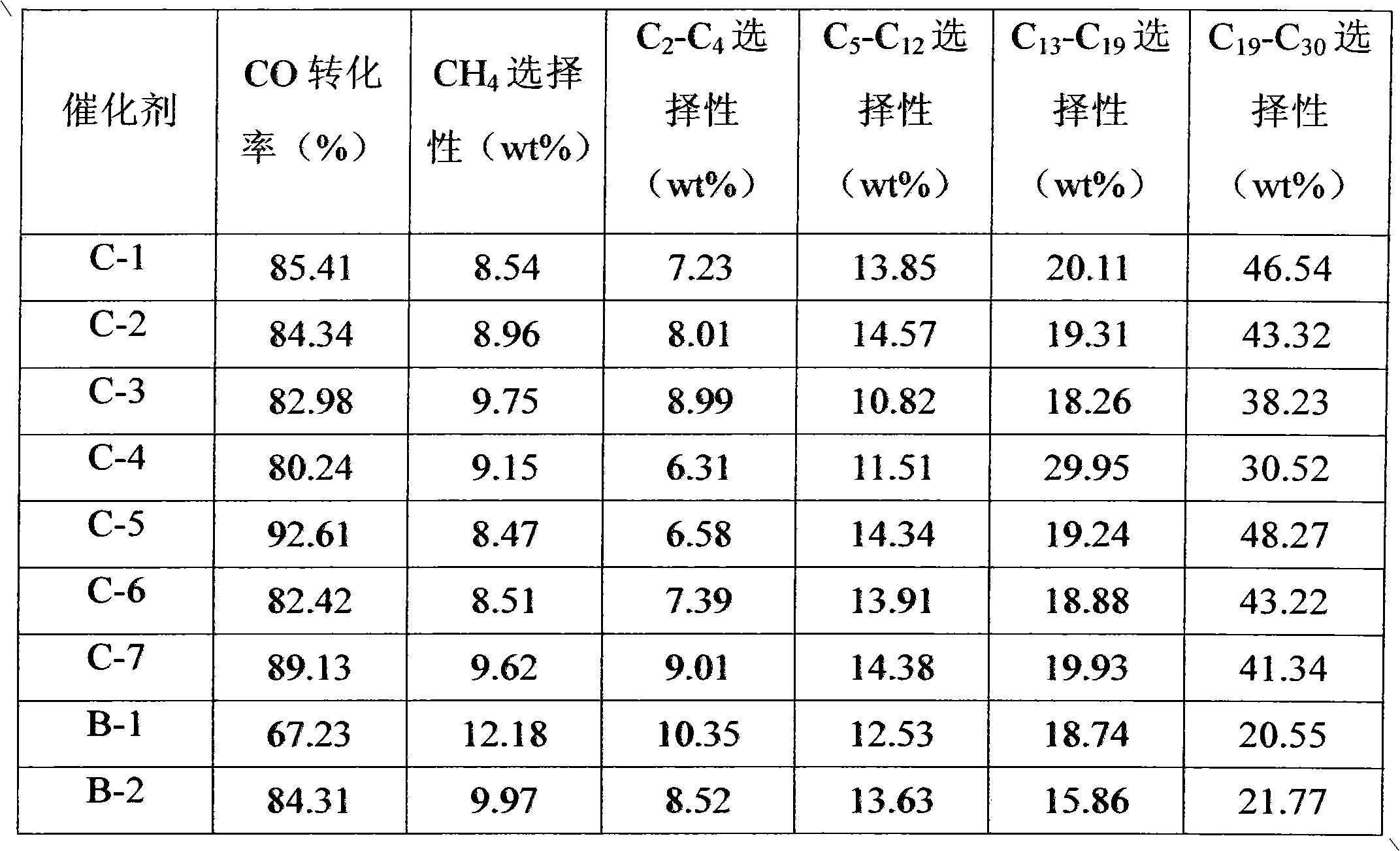Fischer-Tropsch synthesis cobalt-based catalyst using modified silica gel as carrier and preparation method thereof
A Fischer-Tropsch synthesis and catalyst technology, applied in catalyst activation/preparation, chemical instruments and methods, preparation of liquid hydrocarbon mixtures, etc., can solve problems such as poor catalyst stability, increased side reactions, and increased catalyst cost, and achieve product selectivity Improve the effect of simple preparation method and high Fischer-Tropsch reactivity
- Summary
- Abstract
- Description
- Claims
- Application Information
AI Technical Summary
Problems solved by technology
Method used
Image
Examples
Embodiment 1
[0017] Example 1 Preparation of boron-containing alkaline solution.
[0018] Boron-containing alkaline solution A
[0019] The preparation concentration is 39.77gB 2 o 3 / l solution of boric acid. Under constant temperature conditions of 30°C, take 400g of deionized water, add 30ml of ammonia solution with a concentration of 2.94mol / l, then add 35.13g of boric acid, add deionized water to a 500ml volumetric flask to make the volume to 500ml, and the pH of the final solution is 8.7, and its composition is B 2 o 3 39.77g / l (press B 2 o 3 The mass percentage of meter is 4%), NH 3 3g / l. The solution was placed in a closed system at room temperature for 24 hours without significant change.
[0020] Boron-containing alkaline solution B
[0021] 30 ml of ammonia solution with a concentration of 2.94 mol / l was added to the boron-containing alkaline solution A, and ethanolamine was added at the same time. The ethanolamine content of the final solution was 1.5 g / l, and the pH ...
Embodiment 2
[0025] Commercially available silica gel (pore volume is 1.06ml / g, specific surface area is 386.81m 2 / g, 40-60 mesh) placed in 1mol / l ammonium nitrate solution, stirred for 24h, and then fully washed with deionized water at room temperature until the sodium content in the silica gel was lower than 500μg / g. The above silica gel was dried at 80°C for 8 hours, and baked at 350°C for 4 hours. Weigh 100 g of the above-mentioned calcined silica gel, add deionized water dropwise until initial moistening, and the volume of consumed water is 160 ml. The following examples all use the silica gel treated by the above method.
Embodiment 3
[0027] Take 32ml of the boron-containing alkaline solution A prepared in Example 1, add it to 20g of the silica gel described in Example 2 at room temperature, stir until uniform, soak at 20°C for 10 hours, and dry at 80°C for 8 hours, 350°C ℃ for 4 hours, and the boron element in the final catalyst accounted for 2% by weight of the silica gel carrier. According to the weight ratio of zirconium element in the final catalyst to the silica gel carrier of 3%, weigh 2.94g of zirconium nitrate hexahydrate and dissolve it in 32ml of deionized water, add it to the modified carrier silica gel, age for 4 hours, and dry at 80°C for 8 hours. Baking at 350° C. for 4 hours. Based on the cobalt element in the final catalyst accounting for 15% by weight of the silica gel carrier, weigh 14.81 g of cobalt nitrate hexahydrate and dissolve it in 32 ml of deionized water, add it to the above-mentioned sample impregnated with zirconium, age for 4 hours, and dry at 80 ° C for 8 hours. Baking at 35...
PUM
 Login to View More
Login to View More Abstract
Description
Claims
Application Information
 Login to View More
Login to View More - R&D
- Intellectual Property
- Life Sciences
- Materials
- Tech Scout
- Unparalleled Data Quality
- Higher Quality Content
- 60% Fewer Hallucinations
Browse by: Latest US Patents, China's latest patents, Technical Efficacy Thesaurus, Application Domain, Technology Topic, Popular Technical Reports.
© 2025 PatSnap. All rights reserved.Legal|Privacy policy|Modern Slavery Act Transparency Statement|Sitemap|About US| Contact US: help@patsnap.com

